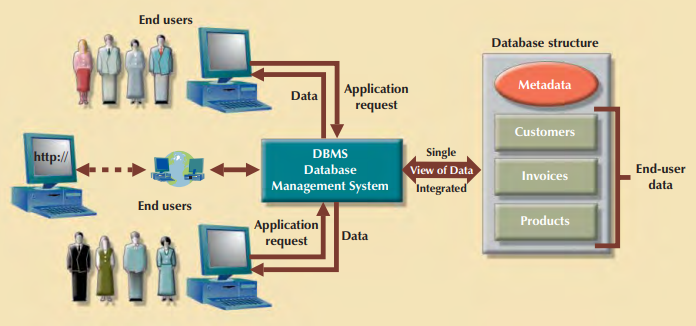The DBMS serves as the intermediary between the user and the database. The database structure itself is stored as a collection of files, and the only way to access the data in those files is through the DBMS
The DBMS receives all application requests and translates them into the complex operations required to fulfill those requests. The DBMS hides much of the database’s internal complexity from the application programs and users. The application program might be written by a programmer using a programming language such as Visual Basic.NET, Java, or C#, or it might be created through a DBMS utility program

Because data are the crucial raw material from which information is derived, you must have a good method to manage such data. As you will discover in this book, the DBMS helps make data management more efficient and effective. In particular, a DBMS provides advantages such as:
- Improved data sharing. The DBMS helps create an environment in which end users have better access to more and better-managed data. Such access makes it possible for end users to respond quickly to changes in their environment
- Improved data security. The more users access the data, the greater the risks of data security breaches. Corporations invest considerable amounts of time, effort, and money to ensure that corporate data are used properly. A DBMS provides a framework for better enforcement of data privacy and security policies
- Better data integration. Wider access to well-managed data promotes an integrated view of the organization’s operations and a clearer view of the big picture. It becomes much easier to see how actions in one segment of the company affect other segments
- Minimized data inconsistency. Data inconsistency exists when different versions of the same data appear in different places. For example, data inconsistency exists when a company’s sales department stores a sales representative’s name as “Bill Brown” and the company’s personnel department stores that same person’s name as “William G. Brown,” or when the company’s regional sales office shows the price of a product as $45.95 and its national sales office shows the same product’s price as $43.95. The probability of data inconsistency is greatly reduced in a properly designed database.
- Improved data access. The DBMS makes it possible to produce quick answers to ad hoc queries. From a database perspective, a query is a specific request issued to the DBMS for data manipulation—for example, to read or update the data. Simply put, a query is a question, and an ad hoc query is a spur-of-the-moment question. The DBMS sends back an answer (called the query result set) to the application. For example, end users, when dealing with large amounts of sales data, might want quick answers to questions (ad hoc queries) such as:
- What was the dollar volume of sales by product during the past six months?
- What is the sales bonus figure for each of our salespeople during the past three months?
- How many of our customers have credit balances of $3,000 or more?
- Improved decision making. Better-managed data and improved data access make it possible to generate better-quality information, on which better decisions are based. The quality of the information generated depends on the quality of the underlying data. Data quality is a comprehensive approach to promoting the accuracy, validity, and timeliness of the data. While the DBMS does not guarantee data quality, it provides a framework to facilitate data quality initiatives. Data quality concepts will be covered in more detail in Chapter 15, Database Administration and Security
- Increased end-user productivity. The availability of data, combined with the tools that transform data into usable information, empowers end users to make quick, informed decisions that can make the difference between success and failure in the global economy
